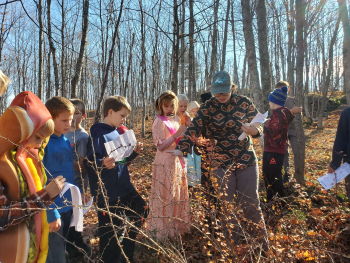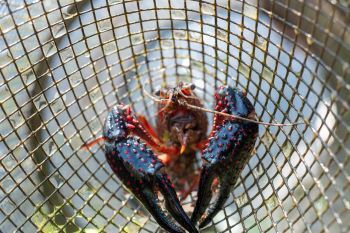|
June 18, 2024
Contact:?Joanne Foreman, 517-284-5814
With nice weather and many species on the move, summer is peak season for invasive species survey and control work across Michigan.
The NotMISpecies webinar series is taking advantage of the field season to share the latest research, survey and response efforts for spotted lanternfly and red swamp crayfish in Michigan. Summer webinars also will highlight the ways innovative teachers are taking advantage of field trips and local experts to inspire students to get involved preventing and managing invasive species.
The monthly series provides free, hourlong sessions for technical experts to share their hands-on experience in invasive species prevention/control and answer questions from viewers.
Students take action

If you?re looking for a successful model for infusing invasive species education into the classroom, Lake Superior State University?s Beth Christiansen has one. For the last three years, she?s brought together students, teachers, natural resource mentors and staff from LSSU?s Center for Freshwater Research and Education to conduct hands-on research into local invasive species issues. In ?Invading Classrooms: Empowering Students to Take Action on Invasive Species? (9 a.m. Tuesday, June 25), Christiansen will share the story of how collaboration has fostered local, student-led stewardship projects to raise awareness and inspire action in communities across northern Michigan.
|
Searching for spotted lanternfly
What?s the status of spotted lanternfly in Michigan this summer? By July, the Michigan Department of Agriculture and Rural Development?s Robert Miller and Lindsay Patrick will know a lot more as they take a break from the field to present ?See It. Squish It. Report It. What You Need to Know About Invasive Spotted Lanternfly? (9 a.m. Wednesday, July 17). Infestations of this invasive insect in both rural and urban areas can be a significant nuisance to residents and visitors. Tune in to learn more about spotted lanternfly, why it?s important to report sightings and how you can reduce the chances of its spread.
Tracking red swamp crayfish

Researchers are working at the cutting edge of science to understand and control invasive red swamp crayfish populations in Michigan. Join Dr. Jared Homola of the U.S. Geological Survey Wisconsin Cooperative Fishery Research Unit for ?Genes on the Move: Understanding Red Swamp Crayfish Spread in Southeastern Michigan?(9 a.m. Thursday, Sept. 12). Learn how genetic tools are revealing biological and environmental factors that could lead to the crayfish's spread, and how understanding these factors is helping efforts to control or potentially eradicate the species in Michigan.
|
The series will take a break in August, leaving ample time to catch up on episodes you might have missed. Find recordings of past NotMISpecies webinars or register for new ones at Michigan.gov/EGLE/Outreach/Not-MI-Species-Webinar-Series.
Michigan?s Invasive Species Program, a collaborative effort of the Michigan departments of Natural Resources; Environment, Great Lakes, and Energy; and Agriculture and Rural Development, coordinates and supports invasive species initiatives across the state and provides support through the Michigan Invasive Species Grant Program.
Note to editors: Accompanying photos are available below for download. Caption information follows.?
Festival: Students from Copper Island Academy in Calumet learn about invasive plants during their fall festival.
RSC 2: Invasive red swamp crayfish have been found in ponds and drainages in some areas of southeast Michigan.
|